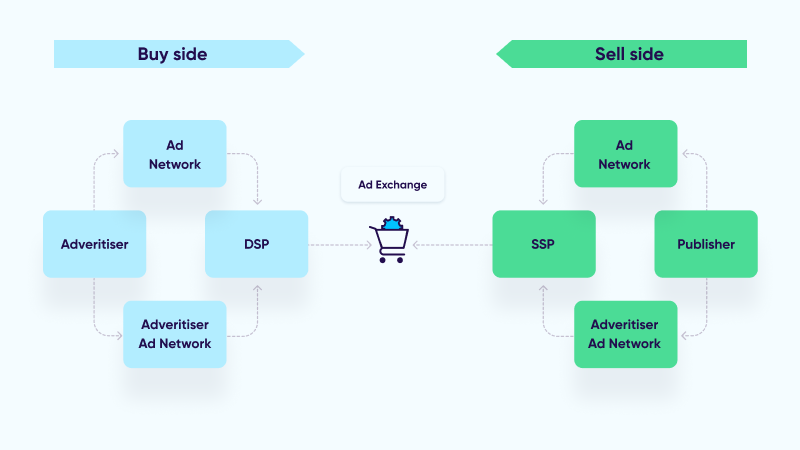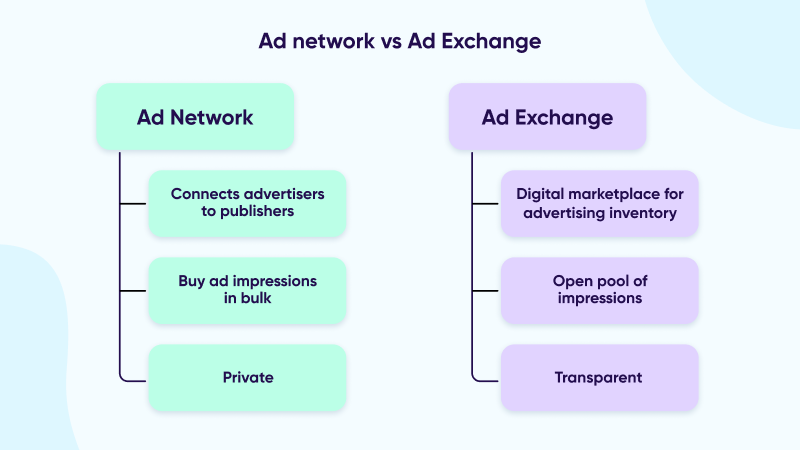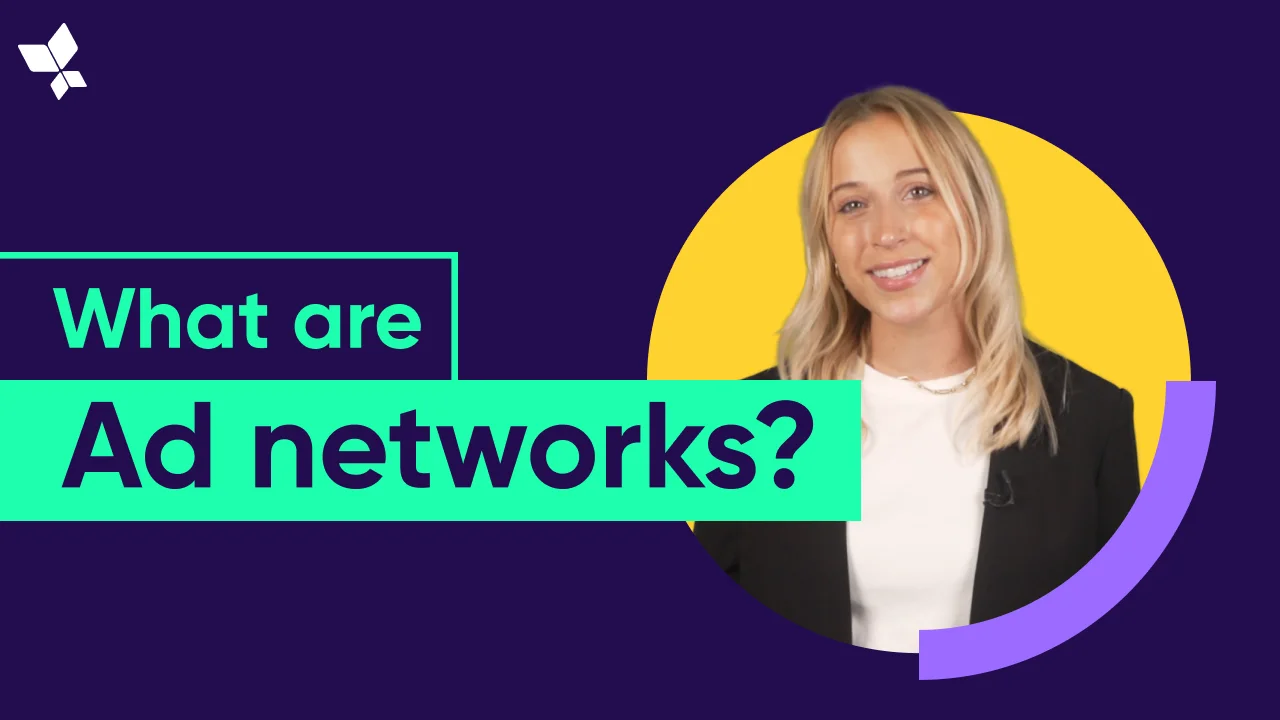
Ad network
Ad networks connect advertisers to publishers/websites with valuable impressions. The essential function of an ad network is to take the collection of ad supplies from publishers and match it to advertisers’ demands.
What is an ad network?
On the most basic level, an ad network is an intermediary. It’s a platform exclusive to online advertising that mediates the sale of ad inventory between publishers and advertisers.
At the dawn of the internet, ad networks were the way publishers unloaded their remnant inventory. Now, where almost everything we do is online, an ad network is an integral part of the programmatic advertising ecosystem.
How does an ad network work?
For publishers, ad networks help secure buyers for unsold ad space. For advertisers, an ad network helps find inventory that suits their budget and audience:
- Publishers install the ad network(s) of their choice, while advertisers set up their ad campaigns through the ad network(s) of their choice.
- The advertisers create their campaigns and set the parameters for each one.
- Advertisers can decide things like budget, targeting, and frequency caps.
- Based on the advertiser’s requirements, the ad network determines which publisher is the right one for their ad and brings the two together.

Types of advertising networks
Luckily, advertisers and publishers can choose from a variety of networks to find one that fits their needs. Your audience, ad type, and budget will all shape the network type you pick.
There are four major types of advertising networks to choose from. Understanding what each type offers helps to make that choice easier.
1. Horizontal ad network
This network delivers ads to an extensive inventory base available to the advertiser and offers an extremely broad reach. Horizontal ads are attractive because they offer scale, reach, and numerous opportunities for advertisers to target.
2. Premium ad network
For those publishers that ask for a premium price in exchange for premium access to their inventory, a premium ad network is the answer. These networks work with top-tier publishers only. And they are extremely particular in regards to whom they will partner with.
3. Specialized ad network
Similar to vertical advertising networks, these are restricted to specific inventory. For example, a specialized network can be one that only works with video or mobile ad formats.
4. Vertical ad network
This type of network connects niche advertisers with relevant publishers. Instead of casting a wide net on a horizontal platform, unconventional advertisers can use vertical ones to reach their unique audiences more reliably. For advertisers, this type of ad network provides transparency as to where their ads will run.
Benefits of ad networks
If you’re reading AppsFlyer’s Engineering blog, there’s a good chance you’re an app developer — in which case, an ad network could be a huge monetization opportunity as a publisher.
Or, if you’re hoping to advertise, a network can help you get your promotion in front of the right people. Either way, ad networks are invaluable mediators that help publishers make money and help advertisers create promotions that pay off.
Plus, with projected market volume of $641 billion by 2026 — monetizing your apps is an easy choice.
Integrating ad networks into your digital marketing strategy offers many benefits. Paramount to all of them, though, is it aids in monetizing your app and giving you a piece of the enormous global marketing pie.
For both publishers and advertisers, the benefits are not only worth it — they also include the added benefit of generating income from your app.

Benefits for publishers
- Generates income fast. Once your site is ready and you have enrolled in one or more ad networks, you can start making money — immediately. Ad networks are an easy answer for publishers that need a quick income to cover operational costs.
But, even if your operational costs are minimal or don’t need covering — ad networks help publishers make bank on the fly and stress-free.
- Widens your audience. The best way to get a piece of the growing app market is to monetize a wider audience segment, and that’s exactly what ad networks do. Advertisers place restrictions on the types of audience and traffic they want to receive.
For example, if an advertiser wants to target American visitors, a site geared toward a domestic audience is ideal. However, it does nothing for your bottom line if you are targeting the global marketplace.
Ad networks supplement instantly sold premium ads so that they can be served to a broader group of visitors, widening the monetization potential of the app instead of limiting it.
- Opens you up to more advertisers. Ad networks serve quality and well-targeted ads because they want them to perform well on your site.
The larger the array of ad creatives you serve your visitors, the more “views and clicks” you can potentially generate. This results in an even better chance of money in your pocket.
Benefits for advertisers
- Widens your audience and publisher pool. Because advertisers place restrictions on the audience types and traffic that they want to receive, it can limit the range of impressions they get.
When advertisers work through an ad network, they increase their pool of publisher supply, thereby increasing their audience reach and all within a predetermined budget.
- Increases your ROI. Ad networks employ precise matching, which allows advertisers to choose the most profitable deals for them.
Ad networks and the programmatic advertising ecosystem
The automatic buying and selling of digital ad space is known as the programmatic advertising ecosystem, which links advertisers to the ad exchange and to the valuable impressions they are always searching for.
The ecosystem runs on RTB (real-time bidding), DSPs (demand-side platforms), SSPs (supply-side platforms), and DMPs (data management platforms).
It’s important to bear in mind that these two concepts of ad networks and the programmatic ecosystem are distinct.
Ad networks are manual, so they require human intervention. A manager is often responsible for accepting the ad creatives and setting up the campaigns.
As programmatic advertising becomes more sophisticated, ad networks may become obsolete in the future. And while ad networks fall under the programmatic direct category and not the programmatic advertising ecosystem, it’s still often confused for different parts of the ecosystem.
Ad network vs. ad exchange

An ad exchange is a digital marketplace for programmatic advertising. Ad networks manage digital inventory from numerous publishers or purchase bulk ad impressions from the ad exchange and then resell them to advertisers.
On the other hand, ad exchanges are the more transparent and efficient means of buying and selling digital advertising. The ad exchange uses algorithms, permitting publishers to get the best prices for their impressions.
At the same time, advertisers can reach target audiences at the right moment and with the appropriate context, in place of negotiating buys directly or manually with publishers.
In short, exchanges allow advertisers to buy ads across a spectrum of mobile apps, mobile websites, and regular websites at once.
Ad network vs. DSP vs. SSP
DSPs and SSPs are parts of the programmatic ecosystem and employ real-time bidding technology. Most ad networks are still completely manual and would need a DSP to participate in RTB and programmatic media buying.
Demand-side platforms allow advertisers to manage their campaigns across multiple RTB networks (instead of just one), and allow advertisers to buy and manage video and mobile and search ad inventory.
DSPs connect with supply-side platforms to enable programmatic advertising, while SSPs help publishers list their available impressions/advertising inventory.
An ad network, on the flip side, is an intermediary and an aggregate that relies on human intervention instead of machine learning and algorithms.
Ad network vs. ad server
The best way to recognize the difference between an ad network and an ad server is to understand that an ad network uses / employs an ad server.
An ad server is the technology that allows advertisers to place their ads on specific sites or apps and also enables publishers to manage these ads properly. An ad network employs this technology (ad server) to manage ads and available publisher inventory.
How to choose the right ad network
There are so many ad networks to choose from that it can feel overwhelming. However, if you consider the following four things before your search begins, choosing the right ad network can actually feel kind of painless.
- How extensive is the network? Whether your site is niche or global in reach, consider this question. The more advertisers that can bid for your inventory, the greater the potential to sell those valuable impressions at higher prices.
Think about it. An extensive publisher inventory indicates an ad network with more opportunities to match ads to websites appropriately. This is known as CTR or contextual targeting which is the process that matches ads to relevant sites in the Display Network based on linguistic elements like topics and keywords.
In addition to offering better contextual targeting, a larger pool of advertisers also means that a greater number of geographical locations are represented. Ultimately, this reduces the chances that you’ll be left with unsold inventory — and that goes for both publishers and advertisers.
- Does it offer a variety of formats? Even if you are unsure which formats you may need — look for an ad network that offers a variety of ways to display ads. Then you can test and adapt over time.
When it comes to ad performance — one size does not fit all. An ad network that offers multiple ad formats(rich media, video rolls, interstitials, etc.) optimizes the monetizing potential of both the publisher and the creative.
- Can it compete with RTB or programmatic advertising? Since the programmatic ecosystem challenges legacy ad networks’ long-term viability, publishers must understand the value of automatic ad buying and selling, particularly before considering an ad network and committing to one.
- Programmatic buying and real-time bidding help publishers earn more money. Legacy ad networks definitely cannot keep up. Therefore, it’s more than essential to understand what technologies an ad network offers or can integrate with before deciding to commit to one.
Popular ad networks for publishers and advertisers
Now that you know what to look for in an ad network, here are 10 of the most popular ad networks:
For publishers
Ad tech is growing, and for publishers that want to use it to their advantage and generate more income, here are some prominent ad networks for you:
- Google AdSense
- Facebook Ads
- Media.net
- AdThrive
- Amazon Associates
For advertisers
If you have high-quality ads that entice, these are some of the most popular ad networks for advertisers:
- Apple Search Ads
- Spotify Ads
- AdRoll
- Facebook Ads
- TikTok Ads
Key takeaways
Unfortunately, ad networks are not evolving as fast as the programmatic advertising ecosystem. Because of that, there are important things to remember if and when you are considering an ad network:
- An ad network is an aggregator of publisher inventory and a mediator between publishers and advertisers.
- There are four major types of ad networks: horizontal, premium, specialized, and vertical.
- While not as viable as programmatic, there are still major benefits for both publishers and advertisers that employ ad networks.
- Ad networks still require human intervention as opposed to the programmatic ecosystem, which relies on machine learning and algorithms.
- Before committing to an ad network, it’s important to consider how extensive it is, the variety of formats it offers, and if it can compete with RTB.




